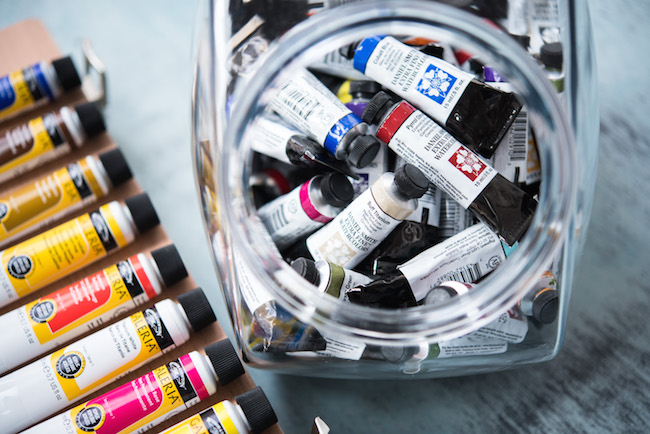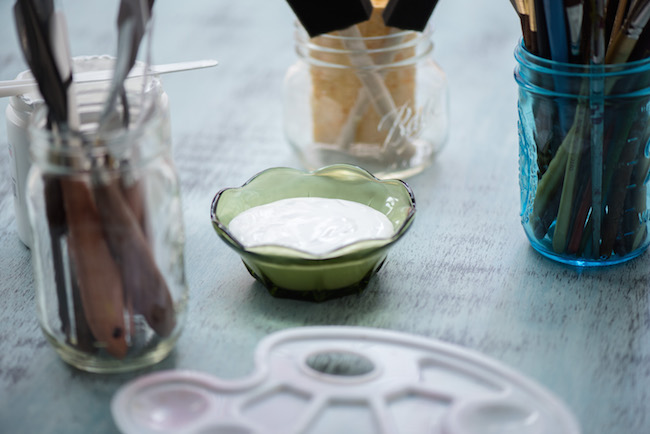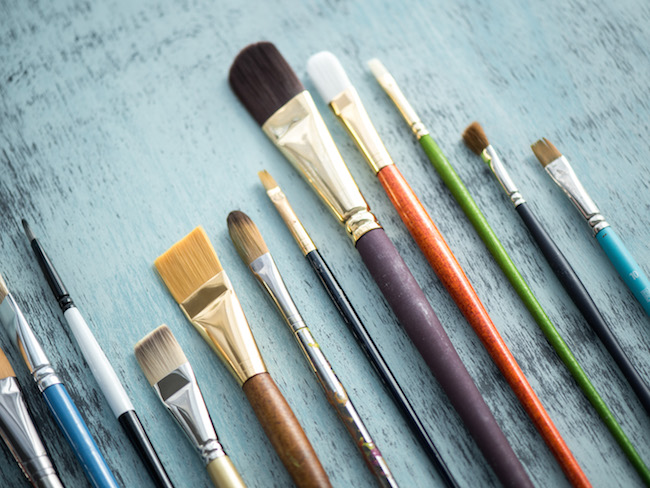 Because acrylic is affordable, almost odorless and dries quickly, knowing how to use this medium has many advantages. With a few tips and tricks (like additives or finish), you can manipulate acrylic to mimic anything from the softness of watercolors to the boldness of oil paint.
Because acrylic is affordable, almost odorless and dries quickly, knowing how to use this medium has many advantages. With a few tips and tricks (like additives or finish), you can manipulate acrylic to mimic anything from the softness of watercolors to the boldness of oil paint.
What are the must-have materials and tools materials for acrylic painting? Let’s find out!
Acrylic 101: the paint
 The texture and packaging of a acrylic paint vary greatly. Texture of the paint differs from thick to runny liquid, and the paint could be packaged in a tube, jar or dropper bottle. These differences will influence the painting style. For example, liquid acrylic creates a watercolor effect while thick acrylic will be better suited for techniques like impasto painting.
The cost of acrylic also influences the effect the paint will have. You can buy student or professional quality paint. The pricier professional quality paints usually have higher concentrations of pigments. More pigments mean you are likely to need less paint to achieve the same brightness and color compared to student quality paint. Additionally, light fastness of student quality paint can cause pieces made with this cheaper acrylic to be more susceptible to fading over time.
The texture and packaging of a acrylic paint vary greatly. Texture of the paint differs from thick to runny liquid, and the paint could be packaged in a tube, jar or dropper bottle. These differences will influence the painting style. For example, liquid acrylic creates a watercolor effect while thick acrylic will be better suited for techniques like impasto painting.
The cost of acrylic also influences the effect the paint will have. You can buy student or professional quality paint. The pricier professional quality paints usually have higher concentrations of pigments. More pigments mean you are likely to need less paint to achieve the same brightness and color compared to student quality paint. Additionally, light fastness of student quality paint can cause pieces made with this cheaper acrylic to be more susceptible to fading over time.
Change paint texture with simple additives
 You can add different mediums to acrylic to modify its properties. Retarder, for example, will increase the drying time of acrylic, making the acrylic behave more like oil paint. By slowing the drying time, you are left with more time to work and make changes on the painting.
You can also manipulate the paint’s transparency. Gel mediums will increase transparency, making it easier to paint layers of semitransparent paint or glazes. Acrylic can also be diluted in water. However, be cautioned not to add too much water. The binder will not hold the pigments together and you might end up with uneven color or color that easily lifts from the surface.
You can add different mediums to acrylic to modify its properties. Retarder, for example, will increase the drying time of acrylic, making the acrylic behave more like oil paint. By slowing the drying time, you are left with more time to work and make changes on the painting.
You can also manipulate the paint’s transparency. Gel mediums will increase transparency, making it easier to paint layers of semitransparent paint or glazes. Acrylic can also be diluted in water. However, be cautioned not to add too much water. The binder will not hold the pigments together and you might end up with uneven color or color that easily lifts from the surface.
Use finish to change the end result
Acrylic paint dries hard with a durable finish. Nevertheless, varnishing can still help protect the paint form dust and ultraviolet. Also, if you did apply some paint mixed with gel medium, varnishing the whole painting will ensure consistent shine and prevent the differences in brightness gel medium may cause.Application tools
 When it comes to using different paint tools for applying acrylic paint, the sky is the limit. Acrylic paint can be swept with a brush, applied with a knife, dabbed with a sponge, pressed with a sponge, sprayed with an airbrush…wherever your imagination and creativity take you!
Another note of caution: Once acrylic has dried, it’s very difficult to remove from a brush or tool. Prevent any mishaps by leaving your tools in water while working and rinsing all tools well once you are done. Soap and water should do the job.
When it comes to using different paint tools for applying acrylic paint, the sky is the limit. Acrylic paint can be swept with a brush, applied with a knife, dabbed with a sponge, pressed with a sponge, sprayed with an airbrush…wherever your imagination and creativity take you!
Another note of caution: Once acrylic has dried, it’s very difficult to remove from a brush or tool. Prevent any mishaps by leaving your tools in water while working and rinsing all tools well once you are done. Soap and water should do the job.
Palette
 Surfaces are another method to affect the way you use acrylic. From palette (such as wood), glass, Plexiglas, acrylic and plastic, acrylic palettes work on a variety of surfaces. The ability to remove dried paint will vary based on the overall smoothness of the surface. You could also find disposable artist palettes on the market that can be discarded after use.
Remember, acrylic paint dries very fast, so it can be challenging to keep the color you just mixed wet if you want to be able to use it for a few hours. Some artists regularly spray the paint with water in order to maintain moisture. Another method on the market is a “stay wet” palette, which includes a system of lids, wet sponges, and wet paper, designed to keep the paint moist for hours.
Surfaces are another method to affect the way you use acrylic. From palette (such as wood), glass, Plexiglas, acrylic and plastic, acrylic palettes work on a variety of surfaces. The ability to remove dried paint will vary based on the overall smoothness of the surface. You could also find disposable artist palettes on the market that can be discarded after use.
Remember, acrylic paint dries very fast, so it can be challenging to keep the color you just mixed wet if you want to be able to use it for a few hours. Some artists regularly spray the paint with water in order to maintain moisture. Another method on the market is a “stay wet” palette, which includes a system of lids, wet sponges, and wet paper, designed to keep the paint moist for hours.
Surface
 Acrylic can be painted on many supports, including canvas, wood, artist panels, art boards and paper. Unless you are buying primed, ready-to-paint canvas, your surface needs to be primed.
Many acrylic painters use gesso as a surface preparation before painting. Gesso can be applied on canvas, paper or wood. There are also surface preparation mediums on the market, like absorbent ground or modeling paste. Painted on wood or canvas, absorbent ground will emulate the look of paper when painted with liquid acrylics on top. Contrastingly, modeling paste will allow you to create a 3-D texture to your painting surface.
Acrylic can be painted on many supports, including canvas, wood, artist panels, art boards and paper. Unless you are buying primed, ready-to-paint canvas, your surface needs to be primed.
Many acrylic painters use gesso as a surface preparation before painting. Gesso can be applied on canvas, paper or wood. There are also surface preparation mediums on the market, like absorbent ground or modeling paste. Painted on wood or canvas, absorbent ground will emulate the look of paper when painted with liquid acrylics on top. Contrastingly, modeling paste will allow you to create a 3-D texture to your painting surface.

can I order supplies.